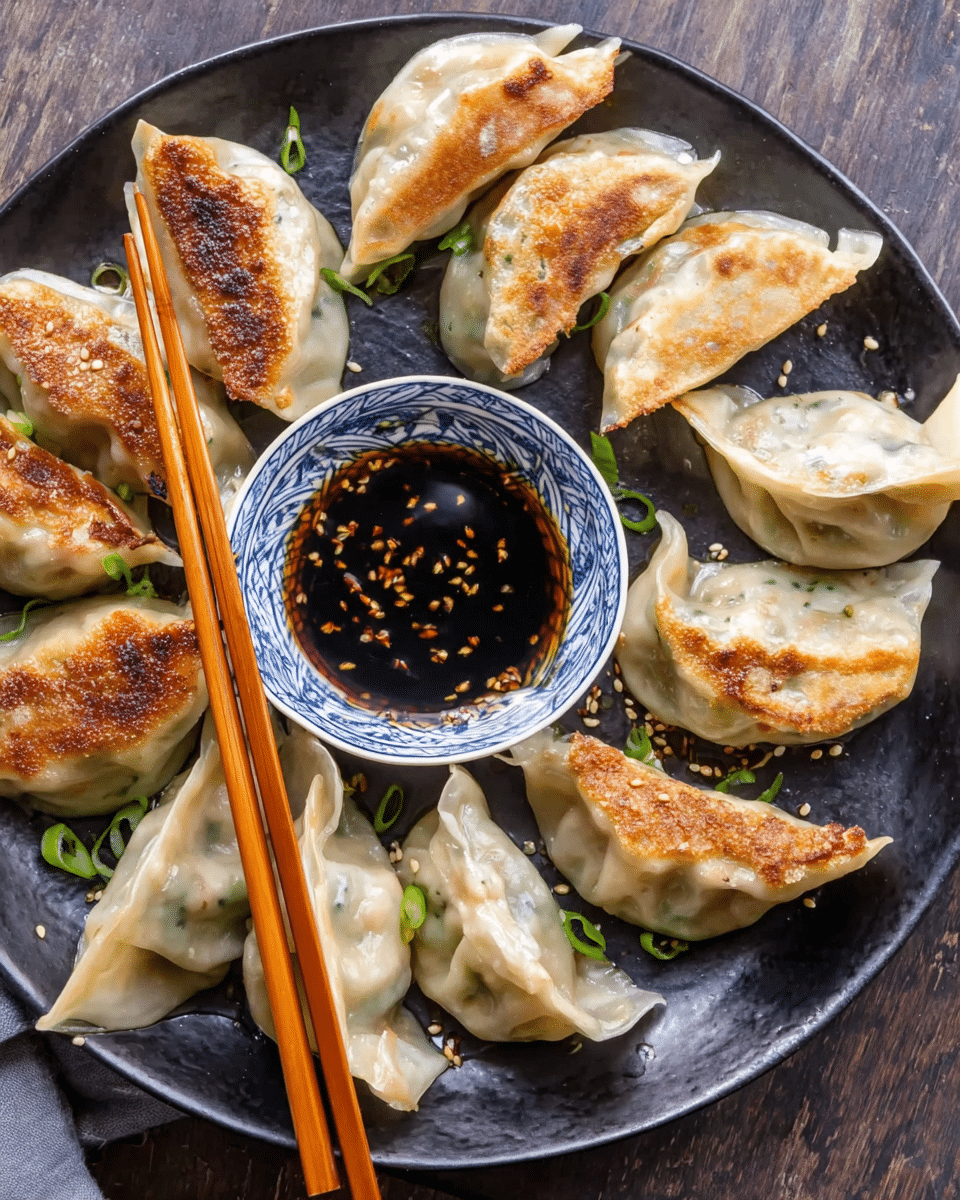This Gyoza recipe is an easy, homemade version of the traditional juicy and crispy Japanese dumplings. Made with thin wonton wrappers, they are stuffed with a flavorful filling of ground turkey, cabbage, and green onions. Pan-fried and then steamed to achieve the perfect texture, these gyozas are deliciously crispy on the outside and juicy on the inside. Serve them with your favorite dipping sauce for an authentic experience!
Full Recipe:
Ingredients
-
52 wonton wrappers
-
1 lb ground turkey
-
1/2 cup green onions, chopped
-
2 cups cabbage, shredded
-
2 garlic cloves, pressed
-
1 tbsp sesame oil
-
1 tbsp soy sauce
-
1 tsp salt
-
1 tsp black pepper
-
1 tbsp oil (for frying)
-
1/4 cup water (for steaming)
Directions
-
In a large bowl, combine the ground turkey, green onions, cabbage, garlic, sesame oil, soy sauce, salt, and black pepper.
-
Place a tablespoon of filling into each wonton wrapper.
-
Brush the edges of the wrapper with water, fold it in half, and pinch the edges to seal the filling inside.
-
Place the sealed gyoza on a baking sheet, leaving space between each one to prevent sticking.
-
Preheat a skillet over medium-high heat and add oil. Place the gyoza flat-side down and cook until golden brown, about 3 minutes.
-
Add 1/4 cup of water to the skillet, cover with a lid, and allow the gyoza to steam for 3-4 minutes until cooked through.
-
Serve immediately with your favorite dipping sauce.
Nutrients (per serving, approximately 1 gyoza)
-
Calories: 41
-
Fat: 1g
-
Saturated Fat: 1g
-
-
Cholesterol: 6mg
-
Sodium: 119mg
-
Potassium: 41mg
-
Carbohydrates: 5g
-
Fiber: 1g
-
Sugar: 1g
-
-
Protein: 3g
-
Vitamin A: 16IU
-
Vitamin C: 1mg
-
Calcium: 6mg
-
Iron: 1mg
The Origins of Gyoza: A Cultural Connection
Gyoza has its origins in China, where it is known as “jiaozi,” a dish commonly served during celebrations, particularly the Lunar New Year. The recipe made its way to Japan in the early 20th century, where it was adapted to suit local tastes. While the Chinese version is typically boiled or steamed, the Japanese version—what we know as gyoza—often features a crispy, pan-fried exterior with a tender, steamed inside. This fusion of textures, where the dumpling has both crunch and softness, has become a defining characteristic of gyoza.
Although gyoza is widely popular in Japan, it has transcended borders and is now enjoyed globally. Whether as an appetizer in restaurants or a beloved homemade dish, gyoza represents the warmth and comfort of Japanese cuisine, with its carefully crafted flavors and textures offering a unique experience for every bite.
Why Turkey? A Lean Twist on a Classic Filling
The filling of gyoza typically consists of ground pork, which is known for its juiciness and rich flavor. However, in this recipe, ground turkey is used as a leaner alternative without sacrificing flavor. Ground turkey retains moisture when cooked, keeping the filling juicy and tender, just like its pork counterpart. Moreover, turkey provides a lower-fat, higher-protein option, making this gyoza recipe a healthier choice without compromising the delicious, savory taste that defines gyoza.
The addition of shredded cabbage also helps keep the filling moist and adds a subtle crunch, while green onions offer a mild yet zesty flavor. Garlic, sesame oil, and soy sauce bring depth to the filling, creating a balanced and harmonious taste profile that is both savory and aromatic. The combination of turkey and vegetables makes for a flavorful, satisfying bite that pairs perfectly with the crispy skin.
The Key to the Perfect Gyoza Wrapper
The wrapper is just as important as the filling in gyoza. The delicate, thin texture of the wrapper allows the dumplings to crisp up beautifully during cooking. Wonton wrappers are often used in homemade gyoza recipes because they are thin and pliable, making them perfect for wrapping around the flavorful filling. When cooked, these wrappers develop a crisp, golden exterior that contrasts with the soft, juicy interior, creating the signature texture of gyoza.
To assemble the gyoza, each wrapper is filled with a spoonful of the turkey mixture, and the edges are sealed by pinching them together. This step is important not only for holding the filling securely but also for shaping the dumplings into the classic crescent form. The act of sealing the gyoza also ensures that none of the flavorful filling escapes during cooking, keeping every bite packed with taste.
The Cooking Method: Pan-Fried and Steamed to Perfection
The cooking method for gyoza is one of the keys to achieving the perfect texture. First, the gyoza is pan-fried in a bit of oil, allowing the bottoms to become golden brown and crispy. This crispy base adds texture and flavor to the dish, creating a satisfying crunch with every bite. The next step involves steaming the gyoza to ensure the filling is fully cooked and the wrapper becomes tender. A small amount of water is added to the pan, and the skillet is covered with a lid to trap the steam, gently cooking the gyoza through while maintaining the crispy exterior.
This two-step cooking method—pan-frying followed by steaming—ensures that the gyoza achieve the perfect balance of crispy and tender. The crispy bottom and soft top make the dumplings easy to eat with chopsticks, offering a delightful contrast in every bite. The combination of textures is what makes gyoza such a popular and addictive dish.
The Importance of Dipping Sauce
A key component of enjoying gyoza is the dipping sauce. Gyoza is often served with a simple dipping sauce made from soy sauce, rice vinegar, and sometimes a hint of chili oil or sesame oil. The salty, tangy, and slightly spicy flavors of the dipping sauce complement the savory, juicy filling of the gyoza perfectly. Each bite dipped into the sauce enhances the overall experience, making it even more irresistible.
You can easily customize the dipping sauce to your taste. For a spicier version, add more chili oil or even fresh chili peppers. For a milder sauce, stick with soy sauce and rice vinegar, or experiment with other seasonings like garlic or ginger to elevate the flavor.
Serving Gyoza: A Versatile Dish for Any Occasion
Gyoza is a versatile dish that can be served as an appetizer, main course, or side dish. Whether you’re hosting a dinner party or enjoying a cozy night at home, gyoza makes for a satisfying and fun meal. The dumplings are perfect for sharing, making them an ideal choice for family gatherings, potlucks, or casual get-togethers. You can serve them with steamed rice, a side of vegetables, or a simple salad for a complete meal.
Gyoza can also be served in a variety of ways depending on the occasion. For a traditional Japanese meal, serve them with miso soup, pickled vegetables, and rice. If you’re looking for something a bit more casual, gyoza pairs wonderfully with beer or sake, making it a great addition to a laid-back gathering with friends. The combination of juicy filling and crispy texture makes gyoza a crowd-pleaser that can be enjoyed by people of all ages.
Healthier Homemade Gyoza
Making gyoza at home offers several benefits over store-bought or restaurant versions. First and foremost, homemade gyoza allows you to control the ingredients, ensuring that they are fresh and free from artificial additives. By using ground turkey instead of pork and adding a generous amount of vegetables, this recipe offers a healthier alternative to traditional gyoza without compromising on flavor. You can also adjust the seasonings to suit your personal preferences, making the gyoza uniquely your own.
Moreover, homemade gyoza gives you the opportunity to experiment with different fillings and flavors. While this recipe uses turkey, cabbage, and green onions, you could easily swap these ingredients for others like ground chicken, tofu, or different vegetables to suit dietary preferences. The versatility of gyoza makes it a great dish to personalize and adapt based on what’s available in your kitchen or your specific tastes.
Conclusion
In conclusion, homemade gyoza is a delicious and versatile dish that brings the best of Japanese cuisine into your home. This recipe, with its ground turkey filling, crunchy yet tender wrapper, and authentic cooking method, captures the essence of gyoza while offering a healthier, lighter alternative. Whether served as an appetizer or a main course, gyoza is sure to be a hit at any gathering. With its perfect balance of flavors and textures, it’s no wonder that gyoza has become a beloved dish worldwide. So, why not try making your own batch and enjoy the crispy, juicy goodness of these homemade dumplings with family and friends?






